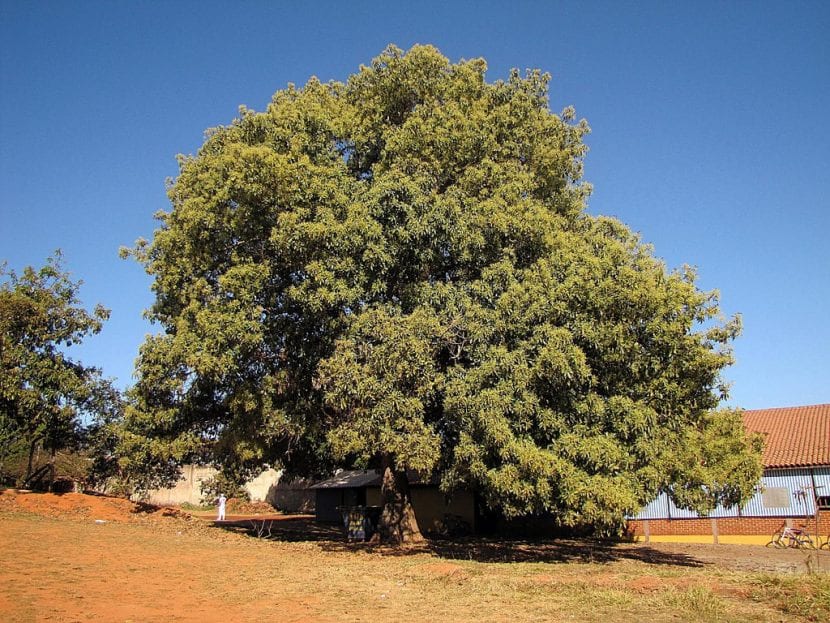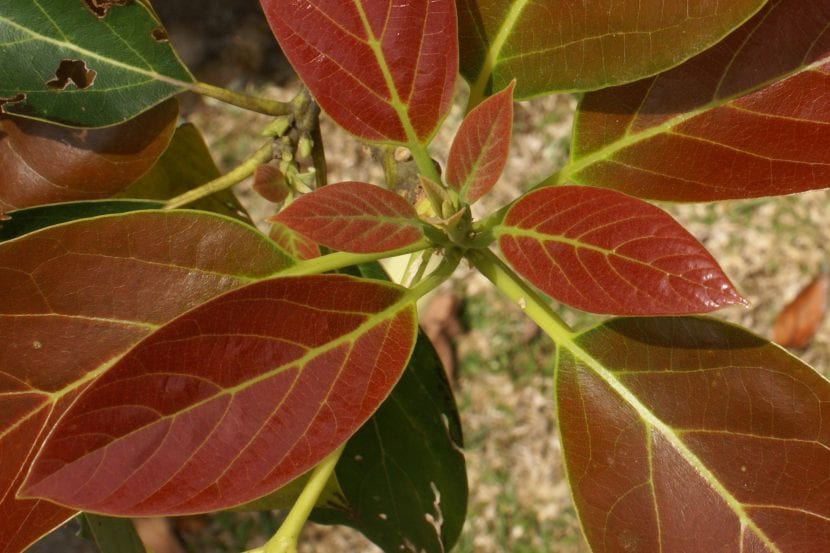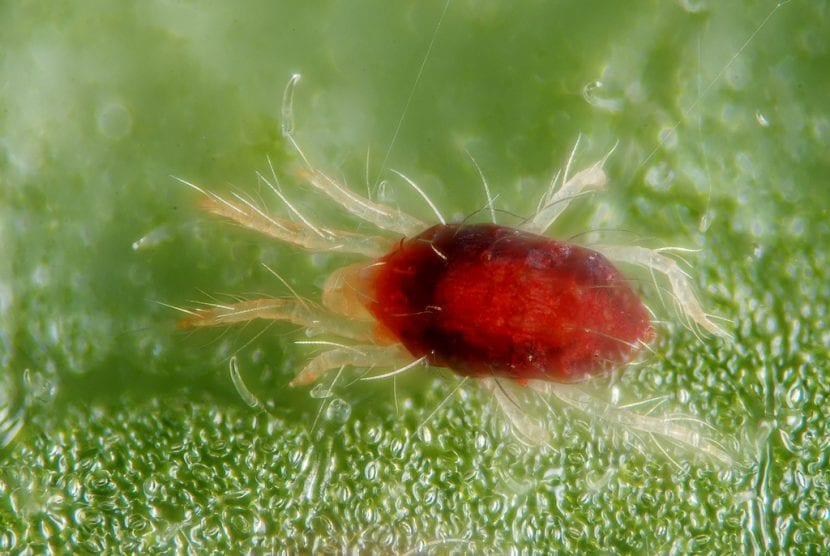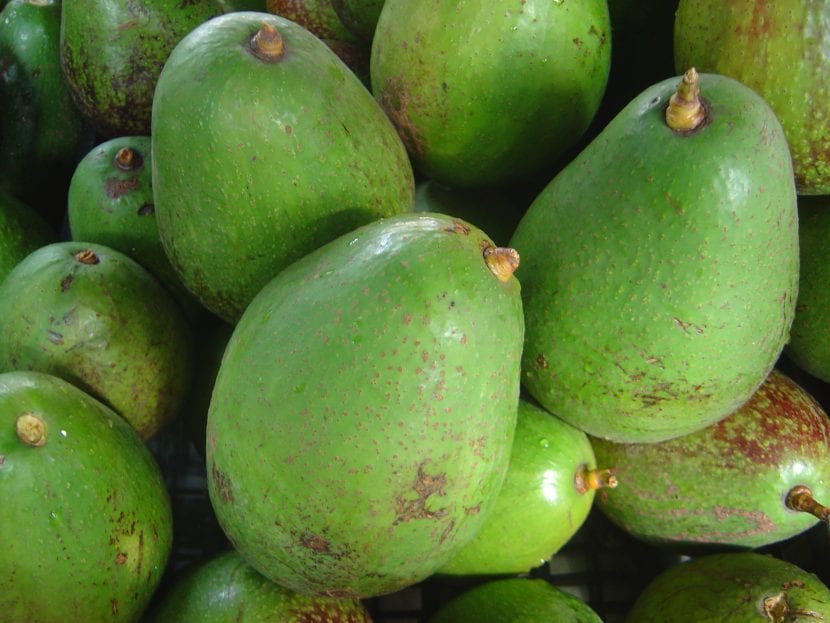
The avocado is by far the most cultivated tropical tree in temperate climate regions. Not only are there varieties capable of withstanding frosts down to -2ºC, but it also provides excellent shade., which is appreciated if you live in an area where temperatures easily rise above thirty degrees Celsius during the summer.
But in addition, they produce a large amount of fruits, enough for the whole family to consume them for a season. So why not cultivate it? 😉
Avocado characteristics

Our protagonist, known by the scientific name Persea americana, and with the common avocado, avocado, avocado, avocado, abacate, abocado or avocado, it is an evergreen tree that is believed to originate in the state of Puebla, Mexico. It grows to a height of 30 meters. Its crown is very dense, and can reach 6-7m in diameter.. The leaves are alternate, pedunculated, bright green, and 10-15cm long.
The flowers are small, white. The female and male do not open at the same time, which prevents self-fertilization. For this reason, it is very important to have several specimens with the same flowering, since this way you will be able to get a very good harvest.
Once they are pollinated, the fruit begins to mature, which is a large yellow-green or reddish-brown drupe, measuring 8 to 18cm long. Its shape is ovoid or globose, and inside there is a globular seed 5 to 6 cm long.
Different varieties of Persea americana are known, the following being the easiest to obtain:
- ettinger: originally from Israel. The fruit is green.
- Strong: is the most widespread. Its origin is in California, and it produces green dotted fruits that ripen in winter.
- Hate: originally from California. It produces black fruits towards the end of the season (late fall / early winter).
How do you take care of yourself?

If you would like to have one or more copies, follow our advice 🙂:
Location
Place your tree in an area where it gets direct sunlight, at a minimum distance of 10m from any tall plant.
Land
Soil or garden soil it should be light, deep, with good drainage (here you have more information on this subject), and with a neutral or slightly acidic pH (5,5 to 7).
The distance between plants in an orchard should be at least 8 meters, being more advisable to be 10m.
Irrigation

Irrigation has to be frecuente, since it does not withstand drought. During the summer, it will be watered every 2-3 days, and the rest of the year every 5-6 days. Use rainwater or water without lime for this. If you can't get it, don't worry. It will be enough to fill a bucket with water, let it rest overnight, and the next day use it for watering.
Subscriber
Throughout the growing season, and being a tree whose fruits are edible, must be paid using organic products, like guano or manure, putting a 2-3cm thick layer around the trunk once a month.
If the plant is young, you can also choose to use liquid fertilizers, guano being especially advisable due to its rapid effectiveness. Of course, you must follow the instructions specified on the package to avoid the risk of overdose.
Planting time
The best time to spend it in the orchard or garden is en spring, when temperatures begin to rise above 10ºC.
Pruning
Only branches that grow close to the ground, weak and diseased branches should be removed in early spring.
Harvest
From the age of five (from sowing) you can start to collect its fruits.
Multiplication

The avocado is multiplied by seeds and by grafting in spring. Let's see how to proceed in each case:
Seeds
- The first thing to do is get a fresh avocado fruit, and eat it 🙂.
- Afterwards, you must clean the seed with water, conscientiously.
- Now, you must sow it in a seedbed with vermiculite, which is a substrate that, in addition to having very good drainage, remains moist for a long time, which will help the seed to germinate. It must be a little buried, otherwise it will not sprout.
- Sprinkle sulfur or copper on the surface of the substrate. This will prevent fungi from damaging it.
- Finally, water.
If all goes well, in a month it will begin to take root.
Grafts
The avocado can be grafted onto Persea indica (Viñátigo canario) and, of course, onto Persea americana. The types of graft that are performed are the "T" shape. To do this, you have to follow this step by step:
- When the trunk of the master plant measures at least 1cm in diameter, a bevel cut is made at 10cm high and treated with fungicide.
- Now, the branch to be grafted is introduced into the cut.
- It is then attached with tape or graft raffia.
Pests

- Red spiders: They are tiny mites that are shaped like a red spider that weaves its webs between the leaves. You can combat it by mixing 2 cloves of garlic, 2 chillies and half an onion, chopping everything well and strain it and then dilute the mixture in 3 liters of water.
- Leaf winding worm: it is a brown-colored moth whose larvae feed on the leaves, causing serious damage to the plant. You can treat it with Bacillus thuringiensis, which is a bacteria that feeds on worms.
Management

- Root rot: It is caused by excess humidity, either by excessive watering and / or by poorly drained soils. Irrigation should be spaced and the plant treated with systemic fungicides.
- Mildew: It is a fungus that penetrates the tissues of leaves, stems and fruits, causing deformations. It is also treated with systemic fungicides.
- Fusarium disease: is a fungal disease caused by fungi of the genus Fusarium. It affects the root and spreads to the rest of the plant through the stem, in which a kind of white powder will be seen. Often, when it is detected it is too late, but it can be prevented by controlling the irrigation and treating the plant from time to time with fungicides.
Rusticity
La Persea americana is usually a tree sensitive to cold. However, the Hass and Fuerte varieties can be grown outdoors in areas where the temperature drops to -2ºC for a short time.
Can you grow avocado in a pot?
Due to its adult size, it is not a plant that can be kept in a pot for life. There will come a time when you will need to be on the ground.
Even so, it can be grown in a pot for several years if you use a universal growing medium mixed with 30% perlite, and transplant it every two years.
For what do you use it?

Avocado is a tree that is used as an ornamental, but it also has other interesting uses:
Culinary
The fruit, for its characteristic sweet taste, combines very well with different vegetable dishes, like salads. Its chemical composition is as follows:
- Water: 70%
- Proteins: 1,5%
- Lipids: 22%
- Carbohydrates: 6%
- Vitamin A: 40mg / 100g
- Vitamin B1: 0,09 / 100g
- Vitamin B2: 0,12mg / 100g
- Vitamin B6: 0,5mg / 100g
- Vitamin E: 3,2mg / 100g
- Vitamin C: 17mg / 100g
- Potassium: 400mg / 100g
Medicinal
It is antioxidant, which delays aging, protects against degenerative and heart diseases, and relieves migraine pain. The only negative we can say is that, due to its high fat content, it is not recommended to consume it after meals, especially if we do not usually practice sports on a regular basis.
And with this we are done. What did you think of the avocado?
Hello good, the photo that comes out of the avocado leaf underneath that looks like fluff could say what fungus it is since it is derived and how I can fight it thanks
Hello Francisco.
It is mildew. Fungi always appear when either you are overwatering or the humidity is very high.
It is fought with fungicides.
A greeting.
Please, I don't really understand how to go from the avocado pit with root to the definitive land. THANK YOU.
THANK YOU! It helped me a lot for my natural science homework, here I found almost all my homework =)
I have 2 avocado plants in the Greater Buenos Aires area, one of them is more than 25 years old, I obtained it from seed, it was about 10 years in a pot, and now about 15 in the ground, just this year, it began to bloom approx. a month, but the leaves are yellowing and falling, I do not know if it will produce frse maintains
Also green, next to about 3 meters another plant also obtained from seed, sown directly in the ground, is about 15 years old, it never bloomed either, the leaves remain very green. Following instructions on the Internet, I made a cut in the bark for both of them that was then closed, also with wire, ring some branches, put flowering hormones, as I said above, the largest one bloomed for the first time, but the leaves are turning yellow and They fall, please, I will appreciate an answer
Hi Aldo.
Have you checked if they have any plagues? How often do you water them?
The fall of leaves can be due both to a colony of insects that is damaging them, as to an excess or lack of irrigation.
If, for example, recently it rained much more than necessary in your area, and it was difficult for the earth to absorb so much water, it is also possible that your trees are suffering from that.
My advice: see if you have pests, and if so you can treat them with diatomaceous earth o potassium soap. If they are apparently fine, check the soil: dig a hole -small- of about 10 centimeters next to an avocado; if it is very humid, you will see that the color of the earth is darker than that of the surface.
It would also be advisable, if you have not already done so, fertilize the land with Organic fertilizers: guano, manure, worm castings. This way the plants will grow stronger and healthier.
Regards!
More than a month ago I placed the pits or seeds in a glass of water with the toothpicks but to date THE ROOTS DO NOT APPEAR AND THE WEATHER PART DID NOT OPEN, how long does it take
Hello José Luis
If the seed is viable, it may take 2-3 months to germinate.
Don't worry that if it goes well, it will grow roots.
Greetings.
Hello, I have a one year old tree from the seed, and I have been told that if I do not graft an adult avocado tree it will not produce avocados. I would like to know if it is true.
Hi Dolores.
Yes it's correct. Although another option is to buy some other avocado, but it is important first to know if yours is male or female. And that can only be known when it blooms.
Greetings.
I have a plant just transplanted to the pot (10 days) and its leaves began to decay, like they point downwards, is it normal? Do you have too much water? Very little? We are entering spring in Argentina, so I guess the time is right. The color of the leaves is strong green, tending to reddish brown at the tips.
Hello Santiaguito.
In principle, yes, it is normal for the leaves to drop a little. But in order to answer you, I need to know how often you water it and how. It is important to add water until the soil is well soaked every time it is dry or almost dry, but if you have a plate under it, you have to remove the excess water.
Greetings.
Hello, an avocado seed germinated and 1 year ago I passed it to a pot (small), it has divine leaves but its trunk is very thin, so I should plant it in a larger pot next to another germinated seed? I always use them for decoration but I want to encourage myself to see if it can grow and eventually bear fruit (I know it takes years) thanks
Hello Gimena.
For its trunk to grow fat, you have to plant it in the ground (that would be the best), or in a larger pot (but not much more: if the one you have now is 10cm in diameter, you can plant it at a 17cm or 20cm at most).
Regards!